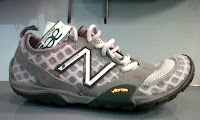Running shoes are used by the vast majority of runners. During the past 2 years you may have watched someone barefoot running on the sidewalk, running track or grass field. Barefoot running differs in a number of ways from runners wearing running shoes.
1. Barefoot runners adopt a different style of running. A barefoot runner will initially strike the ground with the ball of the foot which is followed by gradual lowering of the heel to the ground. This results in the initial impact force being greater underneath the ball of the foot but is reduced by the gradual lowering of the heel to the ground.
2. A runner wearing running shoes will initially strike the ground with their heel or mid-foot which is followed by a gradual lowering of the forefoot to the ground. This results in the initial impact being greater underneath the heel followed by an increase in force underneath the forefoot as the heel lifts off the ground.
3. Barefoot runners have shorter stride length between left and right foot strikes.
4. Runners wearing shoes who are heel strikers will generally have a longer stride length between left and right heel strikes.
5. Muscle activity also differs in a barefoot runner vs. a runner wearing shoes. The calf muscles via the Achilles tendon which inserts into the back of the heel controls the lowering of the heel to the ground.
6. In contrast, a runner wearing running shoes who heel strikes will gradually lower the forefoot to the ground. The anterior shin muscles via the tendons that insert into the top of the foot control the lowering of the foot to the ground.
Running injuries are always a concern whether the runner wears shoes or goes barefoot.
Most of the running injuries that have been documented in the medical literature have occurred in runners wearing running shoes. To date there have no studies documenting the types of injuries resulting from barefoot running. Nevertheless, it is possible to predict the injuries that might occur due to barefoot running.
1. Increased impact underneath the ball of the foot might cause stress fractures in the metatarsals or blistering/callus formation on the plantar skin.
2. Achilles tendonitis may occur due to calf muscle overuse or tight calf muscles.
In the past 25 years, the running shoe industry has developed different categories of running shoes in response to the types of running injuries that have occurred due to faulty lower extremity mechanics.
The four general categories of running shoes are:
1. Cushioning,
2. Mild stabilization,
3. Moderate stabilization and
4. Maximum control.
The cushioning shoe is recommended for a runner requiring maximum shock absorption. The cushioning shoe will be appropriate for a runner with high arches. The maximum control shoe is recommended for a runner with very flat feet requiring support in the arch.
 |
| Vibram 5 Fingers |
The minimalist running shoe is a new category recently introduced by the running shoe companies in response to the interest in barefoot running. The minimalist shoe has been developed to help protect the foot and cushion forefoot impact. The running shoe companies are promoting the style of barefoot running (short stride and forefoot strike) coupled with forefoot protection using the minimalist running shoe. There are four examples of minimalist running shoes pictured.
The minimalist shoe can be recommended to a runner wanting to adopt a barefoot running style with the proviso the runner has no faulty lower extremity mechanics.
 |
| New Balance 10 Minimus Women's |
 |
| New Balance 10 Minimus Trail Men's |
 |
| New Balance 10 Minimus Men's |